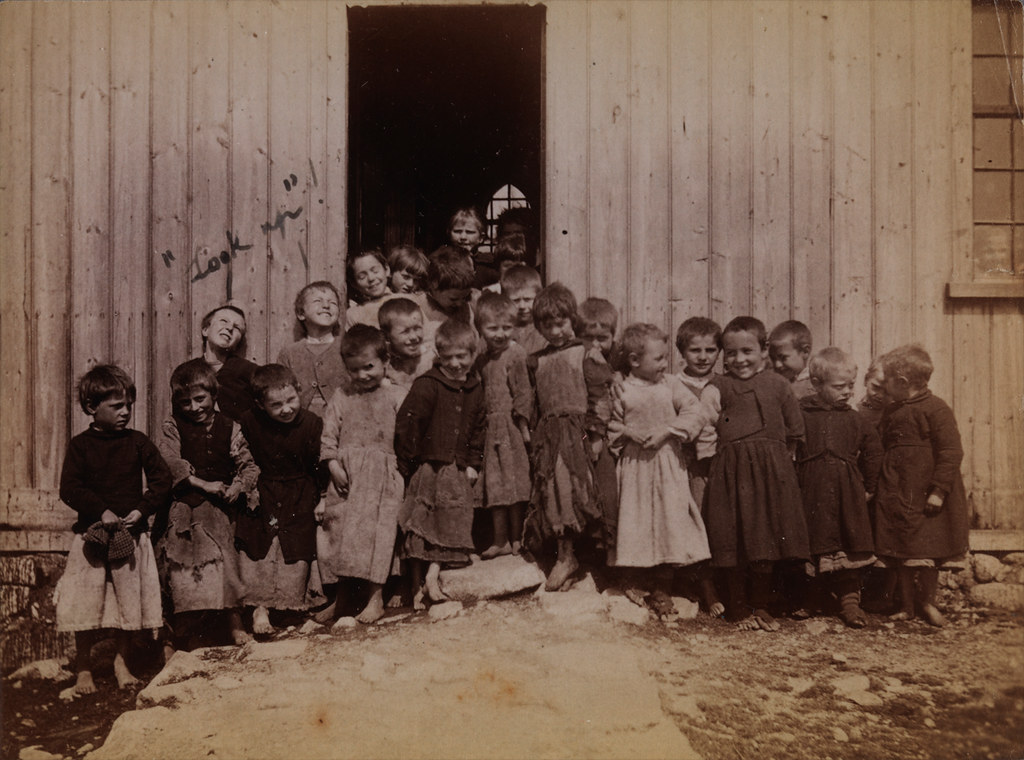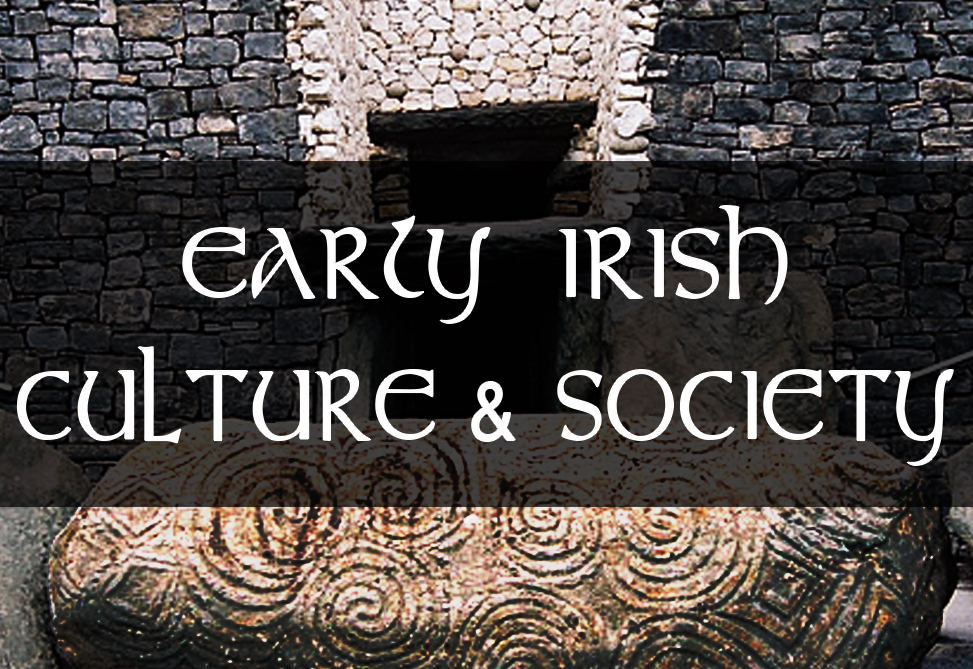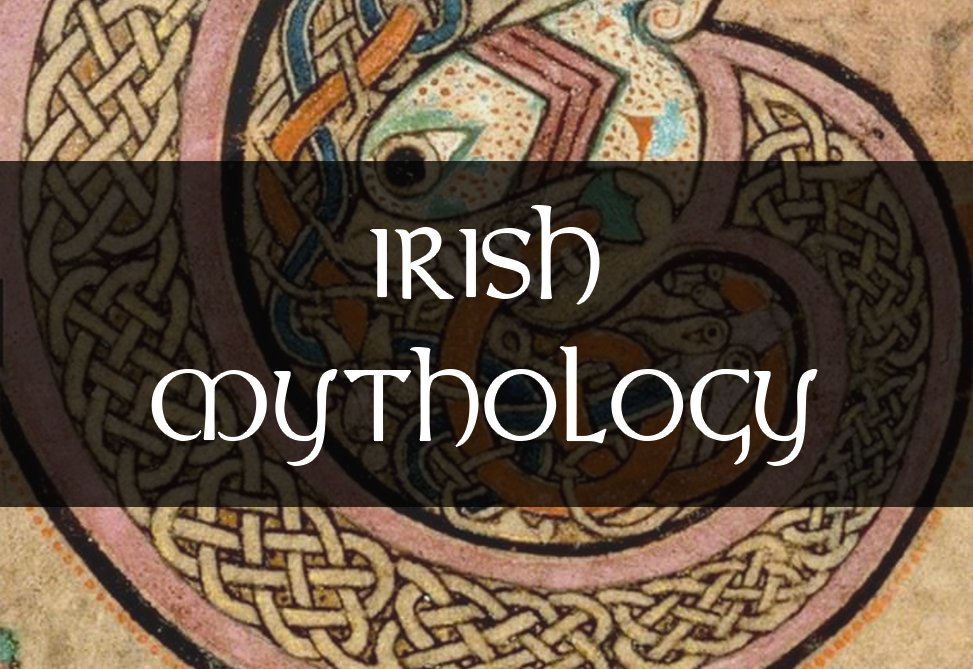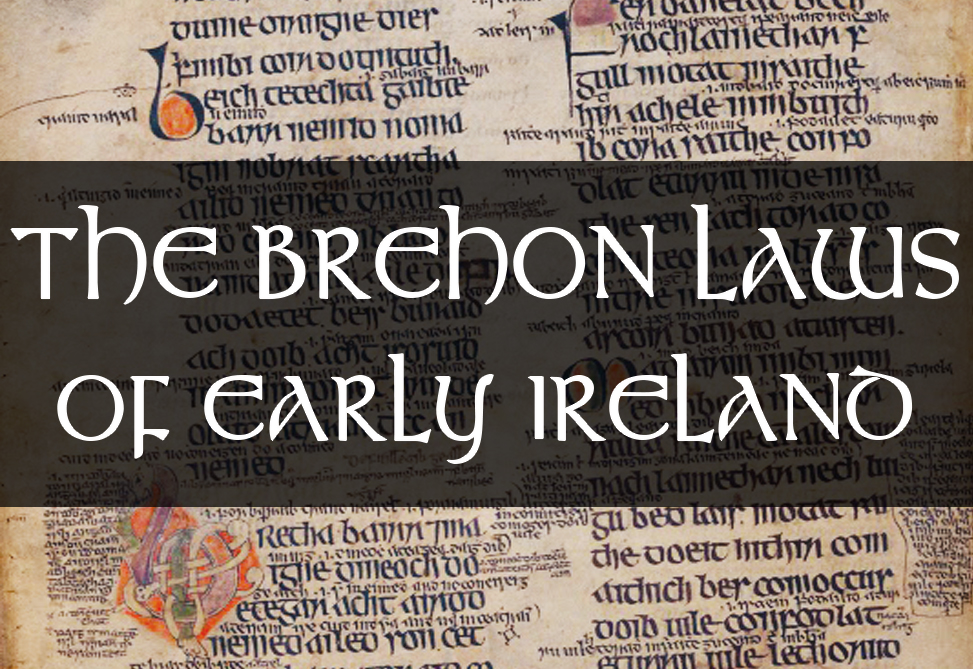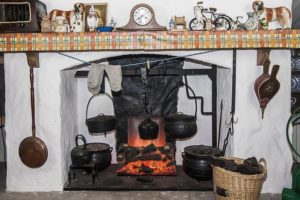Imagine, how brutal and unceasing a beating needs to be to literally beat the language out of the mind of the natives so that they can no longer even think their private inner-most thoughts in their native tongue, the ancient language of their ancestors.
Could Ireland arguably be the most completely colonized country in the world because of this? The colony of the mind, as well as the land.
The term “bata scóir” or “tally stick” refers to a punishment device that was used in Irish schools during the 19th and early 20th centuries to discourage students from speaking Irish and promote the use of English.
The “bata scóir” was essentially a stick or a rod, usually made of wood or sometimes metal, with notches or marks carved into it. Each time a student was caught speaking Irish, a mark would be made on the stick, and after a certain number of marks, the student would be punished, either by being beaten with the stick or by some other means of discipline.
The use of the “bata scóir” was a reflection of the wider policy of the British government at the time, which sought to suppress the Irish language and culture and promote English as the dominant language. While the use of the “bata scóir” has long since been abandoned, it remains a powerful symbol of the cultural oppression experienced by the Irish people under British rule.
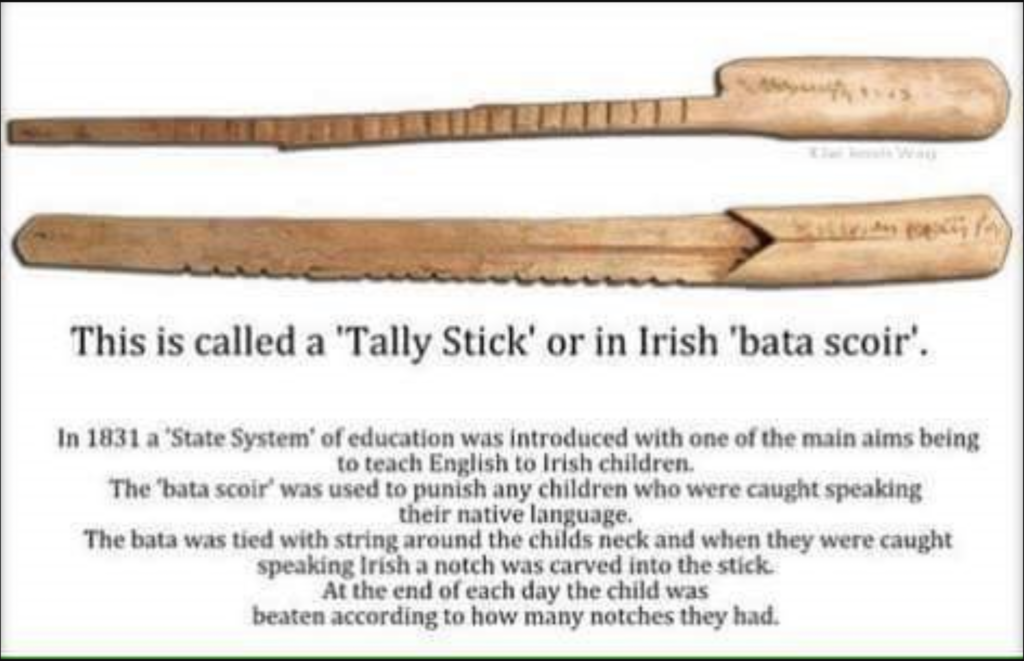
AN BATA SCÓIR: A FIRST-HAND ACCOUNT OF BEATING THE LANGUAGE OUT OF PEOPLE
By: Dr. Matt Treacy, August 2022, GRIPT.
One of the things that intrigues me more as I grow older is what lay behind the conscious abandonment of our language – something that represents the most profound psychological defeat of the Gaelic nation.
There have been numerous theories. De Fréine in The Great Silence seeks to avoid the element of personal agency, on a mass collective scale, and chooses instead to “acknowledge the stupendous determination with which they achieved the goal they set for themselves in the belief that it was for the good of their children.”
There is obviously substance to that in the light of the great calamity that took place in the starvation and forced emigration of the 1840s. Centuries of dispossession and enforced subjugation of the native Irish was justified by the mostly unstated belief, although it is the thread that runs through much of the official and historical narrative, that the “backwardness” of the people, including the language, were partly at fault.
We can always blame the Brits of course, but D.P Moran in the 1890s was having none of that. He claimed that from the United Irishmen on we had substituted politics for any meaningful definition of nationality. He went so far as to state that the more anglicised we became by our own doing, the more irrational our hatred of the Brits. A similar phenomenon was noticed among young Japanese people in the 1950s and 1960s vis-à-vis their schizophrenic obsession with American popular culture, and simultaneous disdain for Americans as a people.
It is undeniable however, that all of the plans on the other side were laid out in law and in writing; from Giraldus Cambrensis through Edmund Spenser and William Petty, for the eradication of “the scume of the Irishe.”
Cambrensis provided the original depiction of the natives of the land newly conquered by Henry II as strange savages. Spenser’s A View of the Presente State of Irelande in 1596, written by a participant in the horrific Desmond wars in Munster where Spenser himself was a beneficiary of the land grab., was a more sophisticated proposal for virtual genocide and the eradication of the Gaelic culture. Ironically, one of the paradoxes which Spenser’s dialogue sought to address was the fact that Ireland had been a literate sophisticated community at a time when England had reverted to pagan barbarism.
The third of the Statutes of Kilkenny enacted in 1367 forbade the settlers from using the Irish language. That was also the focus of the Elizabethans and the Cromwellian surveyor William Petty set out in his The Political Anatomy of Ireland how this could be achieved.
The destruction of the language was a key element of the conquest because that was central to our identity. Spenser knew, as did Stalin and Hitler, that the means to that end was the liquidation of the native elite and intelligentsia. The Elizabethans and the Cromwellians were arguably more successful than the Communists and Nazis, and the Poles never became West Russians at the end of the day.
That is the plausible history behind what happened, but how did that take place in reality? I have sometimes tried to imagine how that process might have taken place in my own family. Two of my grandparent’s families, one on each side, were city people for as far back as I can tell; my mother’s father’s family were from Limerick City. My father’s mother’s family on both sides were Dubs at least as far back as the mid 1800s.
My maternal grandmother’s family was from around Gowran in Kilkenny, and my Treacy grandfather was from Moher, outside Upperchurch in Tipperary. Neither of my Treacy great-grandparents spoke Irish according to the 1901 census although both of them would possibly have had Irish-speaking grandparents. A handful of older people of 356 persons called O’Neill in Kilkenny who had been born earlier than 1850 were recorded in the 1901 Census as having Irish. Just four Tipperary Treacys, of 456, could speak Irish in 1901. Two of them were born in Westmeath and all were young people.
At some point, someone among each of the families of my ancestors made a conscious decision that they, although likely not literate in English themselves, would stop speaking Irish to their children. You might think that is a pretty much impossible intellectual exercise – to put yourself back into the head of people who died maybe 200 years ago – but it happened.
Serendipitously, as I ruminated on this, I happened upon a piece in Béaloideas, the journal of the Irish Folklore Commission, from 1940. It is a transcript of a recording by Antoine Ó Mhaoil Earca from Baingear Iorrais in Mayo. There are other accounts in the folklore records, some of them referred to in a 1940 essay by Seán Ó Suilleabhán in a book dedicated to Professor Éoin Mac Néill.
The pieces concern the bataí scóir, the tally sticks that were placed around the necks of children to “encourage” them to speak English. While it is mostly associated with the National School system that was founded in 1831 and in which English was the only language permitted, there are references to it having been used in schools in Wexford in the 1820s and by masters at the scoil scairte, or hedge schools which are traditionally associated with cultural resistance.
What is certain, and what is saddest about the process, is that while it was introduced by the English administration as part of the ongoing attempt to destroy the Irish language and culture, that it was acquiesced to by large numbers of parents and teachers and other members of the community.
Antoine Ó Mhaoil Earca attended school at Gleann Cuilinn in the late 1850s. His father had taught English during An Gorta Mór in what was known as Blian na mBuilíní – the year of the loaves when children who came to be taught English were given loaves of bread as part of the relief.
Any child heard speaking Irish at national school was given a “clip round the ear,” but the bataí scóir was part of the surveillance outside of the school. It would not have been effective without the widespread collaboration of the community.
Antoine’s mother was the main enforcer in his family and she made them speak English to her despite the fact that she could not understand one word of English herself. Her reason for this was her belief that they would not be able to get work when they emigrated unless they spoke English. His father made the bata scóir from bog deal and it was hung by a string around the child’s neck.
Each time his mother heard one of them say a word of Irish she marked the edge of the stick and their father would give them a slap for each mark when he returned home. Sometimes the beatings were severe; at other times his father would relent and let them off with a warning that it would be worse the next time.
Anyone in the parish could report a child for speaking Irish by calling to see their parents. That apparently was rare but sometimes people did so out of spite so that a child would be beaten. In accounts given to collectors from the Folklore Commission, in some parts of the country the bata scóir, or cipín scóir or maide scóir or capall bán as it was variously known, would be passed from one child to another.
This meant that the last child to wear it would attempt to overhear another, often their own siblings, speak a word or phrase of Irish so they could tell their parents or the master and have the stick passed on to another who would be the next to be punished. One Kerry child stayed awake all night hoping to hear his brother speak Irish so that he could pass the capall bán and any beating onto him. Which meant that the child had to remain silent in the house all night because “ná raibh aon fhocal Béarla ag mo sheana-mháthair.”
Antoine Ó Mhaoil Earca told the same tale:
“Biodh faitchios orainn Gaedhilge a labhairt, agus ní raibh focal Béarla ar bith ag na sean-daoine. Is minic a déarad said linn nár thuigeadar céard a biodh ghá rádh againn dá dteighmís chuca ag iarraidh aon rud,” We were afraid to speak Irish, and the old people had no word of English. Often they said to us that they didn’t understand what we were saying if we came to them looking for something.
That is surely a more heart-rending summary of what happened to us as a people than any speech from the dock.
A common trick, reported from Kerry, to get another child to speak Irish was to ask them directions or something else related to local places in English. Of course they often had no other words than in Irish for the fields and houses and lanes and hills about them. In Cork it was claimed that Monday was the worst day for beatings because informers would have had lots of evidence from listening to the children when they had been free of school and home and out playing by themselves and expressing themselves in their own tongue.
Apart from the economic pressure to learn English in order to be able to migrate for work, in some places the use of English was part of the system of landlordism. An account from Longford told of how the local Church of Ireland parson visited the school to inspect the chart kept on children who were caught using Irish. He reported to the local landlord and occasionally parents who were remiss in all of this were threatened with eviction.
Nor were the Catholic clergy blameless. Archbishop McHale of Tuam denounced the system but many priests were happy to encourage it. Often where such systems of control are in place, as we know from other shameful episodes in our history, they allow for deviant individuals to exploit them for their own perverted pleasure. In parts of Kerry the most severe punishment for speaking Irish was a “hoising” whereby an older boy took the smaller miscreant on his back to whom was administered a “léasadh gan trugh,” a beating without mercy. Perhaps that is where the capall bán originated?
On the upside of all this, there were places where most people refused to take part in enforcing the bata scóir and it seems to have died out by the late 1870s although by that stage the process of anglicisation had been so successful that it appeared to people like Douglas Hyde and Fr. Peadar Ó Laoghaire and the other early activists of the Gaelic League that the language would die unless steps were taken to revivify the Gaeltachts and encourage Irish people generally to speak their own language.
There are accounts from Cork of the local “toughs” refusing to belittle themselves by wearing the stick and taking bad beatings for that reason. In Na Gleanntaí in Donegal, one over enthusiastic school master who spent over an hour at a time beating errant children was attacked on his way home on a dark night.
“Ba mhaith an airidhe sin air, de bhrigh go raibh sé a’ déanadh éagchoir mór orainn, ag iarraidh a bheith a’ tabhairt orainn teangaidh a labhairt nach rabh a’n fhocal daoithe againn ach oiread leis na lacháin.”
The Cork “toughs” and the Gleanntaí boys preserved whatever there was of spirit in our people, but it would be too harsh perhaps to say that many of the rest of us lay down?
It was, as De Fréine noted, the natural instinct of parents to protect their own children. In the context of Ireland of the 19th century, especially in the midst of or the aftermath An Gorta Mór, that was literally a matter of life and death. Acquiring English then was seen by many as an essential key to survival either at home or on the other side of the Irish Sea or the Atlantic ocean.
Education in general was highly valued, as it had been in Ireland for centuries before the arrival of the Normans and Saxons, but the paradox that faced people from the 1830s on was that education was only available through the medium of English. Irish was banned in the schools and the earlier system of education outside of English control in the scoil scairte began to fall apart as both teachers and children were drawn into the national schools.
It is also the fact, as Gerard O’Brien noted, that the Catholic Church might have “chosen to set themselves at odds with Anglicisation” but did not. Nor was the nation’s confidence in their own language and culture boosted by the attitude of Daniel O’Connell, the leader of the first mass democratic movement here, who remarked that the language in which he was reared as a child in Kerry, and through which his aunt Éibhlín Dubh was a renowned poet, might disappear from the face of the earth and cause him no sorrow,
So perhaps we ought not be too harsh on our ancestors. We have never had to face the stark choices many of them had to. At the same time it is not difficult to discern a pattern of conflict between collective cowardice and acquiescence on the one hand; and individual resistance similar to what took place around the wearing of the bataí scóir at other stages of our history up to the present day.
It is better to understand the roots of some of the least likeable characteristics of our people. Especially when there is always an excuse for doing the easy thing on the basis that others will benefit from our lack of backbone.
